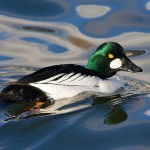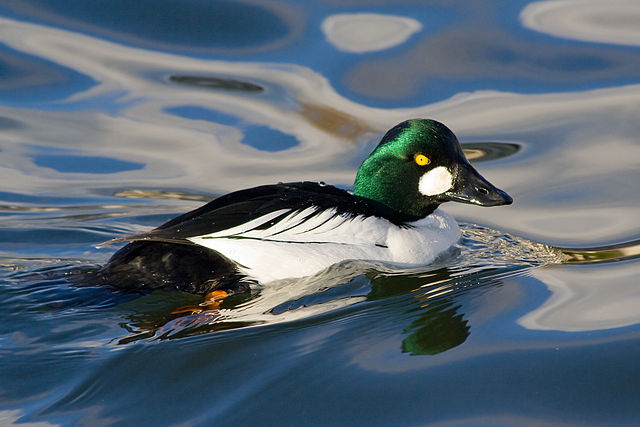Order: Anseriformes
Family: Anatidae
Genus: Bucephala
Species: Bucephala clanngula
Introduction

By Calibas (Own workby uploader) [CC-BY-SA-3.0 or GFDL], via Wikimedia Commons
The female is less striking in appearance. It has a plain brown head with a white stripe at the bottom of the neck. Its back is grey with black wings and white secondaries. Its eyes and feet are the same as the males, but its beak is black with yellow at the tip.(Sibley, 2003)
Insects are also a particularly large part of the diet, accounting for as much as 27% for adults and 70% for juviniles of all food consumed. While the larvae of flies and aquatic insects predominately make up this part of the diet, they are also known to take other insects such as ants. Occasionally, the goldeneye will also catch fish.(Cottam, 1939) They take most their prey within 2 meters of the waters surface. (Ouellet, 2009)
The female responds with a similar courtship display, though some of its moves differ. The female performs a move called the dip where she tips forward, raising her rump and lowering her head into the water. Precopulary acts include ritualized displays of drinking, wing stretching, bill shaking, and preening, among others. Fightning between birds is infrequent.(Benjamin, 1959)
Copulation is short, usually lasting under 15 seconds. The male mounts the female, grabbing her head feathers in his beak and beating his wings.(Benjamin, 1959) It is not known if pairs mate over multiple seasons, though lifelong pairings have been reported in the closely related Barrow’s Goldeneye. (Gauthier, 1987)
The common goldeneye is a cavity nester, laying their eggs in the cavities of trees or human-made nest boxes. They lay from 5 to 16 green eggs. The young are born reletively independent, able to leave the nest box and find their own food with minimal parental care. (Eadie, 1995)
Conspecific brood parasitism is common in the goldeneye. The goldeneye female will often lay her eggs in the nests of other goldeneye females to increase her own reproductive success. It has been hypothesized that the commenality of this behavior is due to the minimal paternal care investment made in the offspring, making parasitism low cost, thus, facilitating little need to evolve a defense mechanism against it. It has also been suggested that female goldeneyes generally paratisize closely related individuals, further lowering the cost of paratasizm as these individuals share genes and thus still benefit, from a reproductive standpoint, in raising offspring closely related to them. (Malte, 1982)
Study of Paratisism patterns show that frequently used nest sites are parasitized more often than less frequently used ones. Females also prefer to parasitize broods earlier in the breeding season than later. This makes sense, as both of these features tend to favor offspring survival.(Poysa, 2003) In broods where the nest is parasitized early, the host females lays fewer eggs. Nest size also tends to be larger in parasatised nests.(Malte, 1982)
Eadie, J. M., M. L. Mallory and H. G. Lumsden. 1995. Common Goldeneye (Bucephala clangula), The Birds of North America Online (A. Poole, Ed.). Ithaca: Cornell Lab of Ornithology; Retrieved from the Birds of North America Online: http://0-bna.birds.cornell.edu.cals.evergreen.edu/bna/species/170doi:10.2173/bna.170
Sibley, David Allen. 2003. The Sibley Field Guide to Birds of Western North America, Alfred a. Knopf, New York: 90.
BirdLife International, 2012. Bucephala clangula. In: IUCN 2012. IUCN Red List of Threatened Species. Version 2012.2. <www.iucnredlist.org>. Downloaded on 06 December 2012.
Cottam, Clarence. 1939. Food Habits of North American Diving Ducks. United States Department of Agriculture:56-65.
Livezey, B. C. 1995. Phylogeny and evolutionary ecology of modern seaducks (Anatidae: Mergini). Condor 97:233-255.
Benjamin Dane, Charles Walcott and William H. Drury. 1959. The Form and Duration of the Display Actions of the Goldeneye (Bucephala clangula). Behaviour, Vol. 14, No. 4:265-281
Poysa, Hannu. 2003. Parasitic common goldeneye (Bucephala clangula)
females lay preferentially in safe neighbourhoods. Behav Ecol Sociobiol 54:30–35.
Eadie, J. M., M. L. Mallory, and H. G. Lumsden. 1995. Common Goldeneye (Bucephala clangula). In The Birds of North America, No. 170 (A. Poole and F. Gill, eds.). The Academy of Natural Sciences, Philadelphia, PA, and The American Ornithologists’ Union, Washington, D.C.
Malte Andersson and Mats O. G. Eriksson. 1982. Nest Parasitism in Goldeneyes Bucephala clangula: Some Evolutionary Aspects. The American Naturalist , Vol. 120, No. 1:1-16
Ouellet Jean-Francois, Guillemette M. and Robert M. 2009. Spatial distribution and habitat selection of Barrow’s and Common goldeneyes wintering in the St. Lawrence marine Canadian Journal Of Zoology, 88(3):306-314.That article in ornus scandinavus http://0-www.jstor.org.cals.evergreen.edu/stable/3676411?seq=5
Nummi Petri, Va¨a¨na¨nen Veli-Matti, and Rask Martti. 2012. Competitive effects of fish in structurally simple habitats: perch, invertebrates, and goldeneye in small boreal lakes. Aquatic Sciences, Vol. 74 (2):343-350.
Gauthier, Gilles. 1987. Further Evidence of Long-Term Pair Bonds in Ducks of the Genus Bucephala. The Auk, Vol. 104, No. 3:521-522


![By Richard Crossley (The Crossley ID Guide Britain and Ireland) [CC-BY-SA-3.0 (http://creativecommons.org/licenses/by-sa/3.0)], via Wikimedia Commons](http://blogs.evergreen.edu/birds/files/2012/10/Common_Goldeneye_from_the_Crossley_ID_Guide_Britain_and_Ireland-231x300.jpg)
Leave a Reply